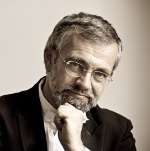Quiz question: name an opera that has been seen in the same city in the same production by more than one million people? It is Giacomo Puccini’s Tosca, of course, in Margarethe Wallmann’s classic production, premiered in 1958 at the Wiener Staatsoper. Could this Guinness Book of Records-worthy production, well passed its 600th performance, still be relevant for modern audiences? It certainly lacks any of the obfuscating challenges of a Regietheater staging, and that may well suit the typical Viennese theatrical taste. It is a solid and realistic, carefully designed production, made stunningly beautiful by Nicola Benois’ imposing set and costume designs.
It is not without its staging inconsistencies, though. The brutalized Cavaradossi is led out from the torture chamber with merely a tiny blood smear on his forehead and a few red specks on his shirt. The scare factor of Scarpia’s completely bloodless murder would be dismissed by most primary school-age students. And when the distraught Tosca explains her horrid, “blood-drenched” night to her lover, he actually turns and walks away from her.
On the positive side, the streamed performance was organised with superb professionalism. The orchestra’s sound was perfectly balanced; one could hear many instrumental collaborations that are near impossible to detect in an actual live performance. The camera work was excellent, subtitles were provided in eight different languages and the lack of audience became obvious only after the silence following the iconic arias. While various concert and opera houses come up with numerous ideas regarding the best presentations of streamed performances during this world-wide pandemic, the attention to detail in this online event was most impressive.
Having performed the role of Tosca at The Met and La Scala and elsewhere in the last few years, Anna Netrebko here made her Viennese role debut. Her utterly seductive character commanded not just her lover, Cavaradossi’s constant attention, but ours as well. Tosca demands a number of lower notes, which she daringly presented with a lush, chesty tone and the middle range of her voice, when she so chose, was mellow, yet powerful. Her jealous rages, sparked by trivial, minor matters, were formidable and the dramatic momentum of her voluptuous voice was irresistible. This did backfire on occasion, for example, (dismissing the composer’s instruction dolcissimo con grande sentiment – extremely sweetly, with great emotion) when introducing “Vissi d’arte”, which risked jeopardising the heartbreaking effect of this aria.
In recent years, Netrebko has regularly been cast together with her husband, Yusif Eyvazov. Unfortunately, the talented tenor hardly impressed on this occasion as Cavaradossi. His facial expression never seemed to change, whether kissed or tortured. His wife’s constantly darting eyes and great stage presence only emphasised the awkwardness of his wooden movements. Ironically, Tosca (in the less than verbatim translated English subtitles) warned him before the Act 3 firing squad: “You have no acting experience”.
The power of Eyvazov's impressive voice – at least through speakers – would have benefited from more judiciously chosen shades of volume in, for example, “O dolce mani” in the final minutes of the opera, which lacked intimacy. His intonation was reliable and his inherent musicality obvious; yet these virtues were overshadowed by the wide and predictable vibrato in “Recondita armonia”. By the time he began the eternally popular “E lucevan le stelle”, he seemed to have even less control over his vibrato, by that stage almost measurable, endangering pitch and the cathartic potential of the aria.
Baron Scarpia, as personified by Wolfgang Koch, was genuinely terrifying. His vile nature came through on many occasions, such as when singing “Già il veleno l'ha rosa!” in Act 1, with its chromatically descending menace, lacking any warmth of vibrato. The startling contrast, at the beginning of Act 2, between Tosca and the excellent chorus singing the serene cantata outside, while he is threatening the hapless Cavaradossi inside, was well assisted by his dark baritone.
Apart from the three protagonists, the success of any Tosca performance depends on the strength of the orchestra and its conductor. The Wiener Staatsopernorchester, conducted by Bertrand de Billy, was in splendid form. As this was a streamed performance, we only saw them briefly during the orchestral introduction to Act 3; however, their supportive presence was always noticeable.
The final fortissimo E flat minor chord of the opera usually acts as a cue to rapturous applause of the audience. On this streamed performance, an eerie silence followed until the sound of the musicians congratulating their conductor drifted into the speakers.
This performance was reviewed from the Wiener Staatsoper livestream




